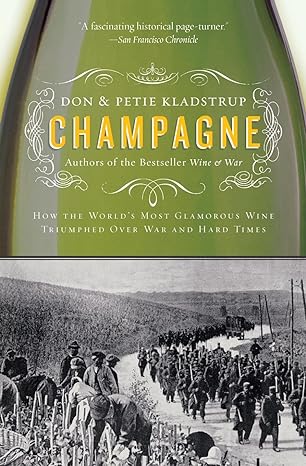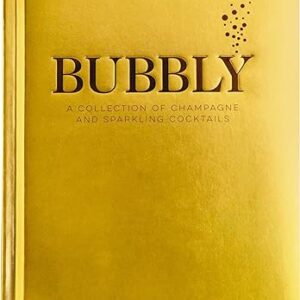Champagne: How the World’s Most Glamorous Wine Triumphed Over War and Hard Times
$18.00
Description
Introduction
Champagne is now seen as the ultimate symbol of celebration and luxury. But the wine’s path to global fame was filled with challenges and setbacks. This book by Don and Petie Kladstrup tells the dramatic story of how champagne makers prevailed over repeated wars, economic depressions, and natural disasters.
Here’s a quick overview of champagne’s turbulent history revealed in this book:
- Champagne’s cold climate made it perfect for fine sparkling wine production.
- Monks in the Champagne region pioneered winemaking techniques in the 1600s.
- Repeated wars between France and England devastated vineyards and sales from the 1600s to 1800s.
- Famous champagne houses like Veuve Clicquot and Moët & Chandon were founded in the early 1800s.
- Railroads and a British taste for bubbly boosted champagne’s popularity in the 1800s.
- World War I and the Great Depression brought enormous hardship to champagne makers.
- Nazis occupied the Champagne region during World War II, threatening production.
- Postwar global demand cemented champagne’s status as a luxury good.
Below is a more in-depth look at how champagne emerged as the world’s preeminent sparkling wine despite a whole succession of formidable challenges.
Chapter-by-Chapter Summary
Chapter 1: Monks and the Wine of Kings
This opening chapter covers the origins of champagne in France’s Champagne region:
- The local cold climate and chalky soil were ideal for fine sparkling wines.
- In the 1600s, monks at the Abbey of Hautvillers began mastering champagne-making techniques.
- The Benedictine monk Dom Pérignon pioneered using corks and blending wines for better flavor.
- French kings and nobility developed a taste for the Abbey’s wines, giving champagne status.
Key fact: Monks created the production methods that gave birth to champagne.
Chapter 2: The Widow with Vision
Here we learn how the widow Madame Clicquot created the first champagne house:
- When her husband died in 1805, Madame Clicquot took over his struggling wine business.
- She made major innovations in production that improved champagne’s quality.
- Her risky move to age wines for longer produced superb vintage champagnes.
- She created the first modern champagne brand and made it a luxury good.
Main takeaway: Madame Clicquot’s visionary leadership made her house world famous.
Chapter 3: Traveling to a Wider World
This chapter examines how railroads enabled champagne to reach new markets:
- New rail lines connected Champagne to Paris and export ports in the 1850s.
- Transport by rail instead of wagon allowed wines to be shipped much farther.
- Exports to countries like Great Britain and the United States boomed.
- Affluent consumers beyond France could now enjoy champagne.
Key fact: Railroads were a major catalyst in champagne’s global expansion.
Chapter 4: Nightmare Landscape
Here we learn how World War I devastated the Champagne region:
- Armies dug fortifications underneath local vineyards during the war.
- Bombardments destroyed many champagne houses and cellars.
- Wine production nearly halted since champagne makers had to flee.
- Vineyards were stripped bare as tanks and copper pans were melted for munitions.
Main takeaway: World War I left the Champagne region in ruins.
Chapter 5: Hatred in the Cellars
This chapter covers how champagne production was impacted by Germany’s occupation of France in World War II:
- The Nazis seized champagne as a spoil of war and celebrated with it in Paris.
- Shipments of champagne to Germany soared while the French had little access.
- Winemakers resisted the occupiers by hiding the best wines out of Nazi reach.
- Allied forces liberated the area in 1944, allowing champagne production to resume.
Key fact: Champagne makers refused to collaborate with the German occupiers.
Chapter 6: Everyone Deserves a Little Luxury
Here we see how champagne became a global symbol of celebration and indulgence after World War II:
- Years of hardship during the wars increased demand for life’s luxuries.
- Exports of champagne surged as it embodied glamour and jubilation.
- Image marketing spread champagne’s associations with parties, romance, and excitement.
- Rising wealth, travel, and status-seeking expanded the clientele for champagne.
Main takeaway: Postwar prosperity positioned champagne as an aspirational luxury.
Chapter 7: A Most Magical Wine
This chapter explores the special allure surrounding champagne:
- Its elaborate production process adds to its mystique and appeal.
- Bubbles make champagne thrillingly different from any other wine.
- Drinking fine champagne conveys status and sophistication.
- Champagne became tied to rituals from christenings to ship launchings.
Key insight: Champagne’s aura of magic explains its global fascination.
Chapter 8: Hard Bubbles to Burst
Here we see how champagne overcame threats from inflation, world wars, and natural disasters:
- In the 1950s, rising costs squeezed profits until prices were increased.
- The oil crisis and recessions of the 1970s shrank champagne sales.
- But demand from wealthy drinkers enabled revenues to rebound.
- Damaging hail, frost, and drought have repeatedly devastated vineyards.
- Yet champagne makers have always found ways to delight customers.
Main takeaway: Through resilience and innovation, champagne has prevailed through every hardship.
Historical Significance
As this book shows, champagne has uniquely:
- Been associated with status and celebration for centuries.
- Survived major wars, depressions, and disasters.
- Maintained its luxury image across the world.
- Been integral to momentous events and rituals.
- Remained synonymous with good times through all hard times.
Champagne is truly a wine like no other in its significance.
Business Innovation
From a business standpoint, champagne producers pioneered many advances, including:
- Branding and image marketing as early as 1800s.
- Region branding by establishing champagne’s protected identity.
- Luxury goods model of higher pricing to increase esteem.
- Vertically integrated production for quality control.
- Network of agents to reach clients worldwide.
- Leveraging elite associations to convey prestige.
The business of champagne was groundbreaking in many respects.
Key Life Lessons
Readers can gain insight on success strategies from this champagne history:
- Innovate fearlessly – keep improving methods and products.
- Wait patiently – some achievements require long timeframes.
- Segment purposefully – focus on your optimal target market.
- Endure stoically – persist through whatever hard times come.
- Prepare diligently – anticipate and manage potential crises.
- Brand powerfully – craft a compelling story around your offering.
- Collaborate strategically – work with partners who expand your reach.
- Delight unceasingly – keep wowing customers with quality experiences.
Conclusion
Champagne provides a fascinating case study of how visionary producers and savvy market positioning allowed a wine region to flourish into a globally revered luxury brand. The champagne story vividly shows how the intersection of quality, scarcity, and aspirational associations can create tremendous commercial value. Anyone interested in luxury goods, branding, business history, or wine will find this book a delightful and illuminating read. Despite facing some of the most difficult challenges possible, from world wars to economic catastrophes, champagne has maintained its magical aura – proof that human ingenuity and tenacity can overcome the toughest of circumstances to achieve enduring success





Reviews
There are no reviews yet.